A block of mass 1 kg is pushed up a surface inclined to horizontal at an angle of by a force of 10 N parallel to the inclined surface (figure) . The coefficient of friction between block and the incline is .If the block is pushed up by 10 m along teh inclined calculate

(a) work done against gravity
(b) work done against force of friction
(c ) increases in potential energy
(d) increases in kinetic energy
(e) work done by applied force Solution in Gujrati
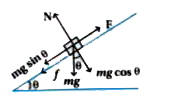
m=1 kg ,
(a) Work done against gravity ,
Vertical distance travelled
(b) Work done against friction ,
Increase in PE = mgh = mg
(e) Work done by applied force ,
W = Fd
= (10) (10) = 100 J
(d) By work -energy theorem , we know that work done by all the forces = change in KE
(W) =
Topper's Solved these Questions
- WORK, ENERGY AND POWER BOOK - KUMAR PRAKASHANCHAPTER - WORK, ENERGY AND POWER EXERCISE - SECTION - E Multiple Choice Questions (MCQs)
64 Videos
- WORK, ENERGY AND POWER BOOK - KUMAR PRAKASHANCHAPTER - WORK, ENERGY AND POWER EXERCISE - SECTION - F Questions From Module (Sample questions for preparation of competitive exams)
23 Videos
- WORK, ENERGY AND POWER BOOK - KUMAR PRAKASHANCHAPTER - WORK, ENERGY AND POWER EXERCISE - SECTION - D NCERT Exemplar Solutions (Short Answer Type Questions)
10 Videos
- WAVESBOOK - KUMAR PRAKASHANCHAPTER - WAVESEXERCISE - SECTION-F (Questions From Module) (Sample questions for preparation of competitive exams)
23 Videos
Similar Questions
The potential energy of 1 kg particle , free to move allong is given by U(x)=(x33−x22)I. if its mechanical energy is 2J . Its maximum speed is …… ms−1
View SolutionA Sphere makes an inslastic collision with another sphere of same mass , then both the spheres are moving .The angle between their direction of motion will be ……..
View SolutionA graph of potential energy V(x) verses x is shown in figure .A particle of energy E0 is executing motion in it . Draw graph of velocity and kinetic energy verses x for one complete cycle AFA.
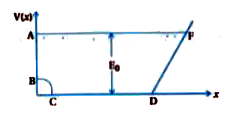
View SolutionIn a standing wave formed by two atoms separated by 1.21Å, there are 3 nodes and 2 antinodes. Find its wavelength.
View SolutionA block of mass 1kg is pushed up a surface inclined to horizontal at an angle of 30^(@) by a force of 10N parallel to the inclined surface [figure] . The coefficient of friction between block and the incline is 0.1. If the block is pushed up by 10 m along the incline, calculate (a) work done against gravity (b) work done against force of friction (c) increase in potential energy (d) increase in kinetic energy (e) work done by applied force.
View SolutionA block of mass 0.1 kg is kept on an inclined plane whose angle of inclination can be varied from theta = 30^(@) to theta = 90^(@) . The coefficient of friction between the block & the inclined plane is mu =1 . A force of constant magnitude (1)/(2)mg newton always acts on the block directed up the inclined plane and parallel to it. Then :
View SolutionA block of mass 1 kg is pushed up a surface inclined to horizontal at an angle of 30∘ by a force of 10 N parallel to the inclined surface as shown in the figure.
The coefficient of friction between block and the incline is 0.1. If the block is pushed up by 10 m along the incline, then the work against gravity is (Take g=10ms−2)
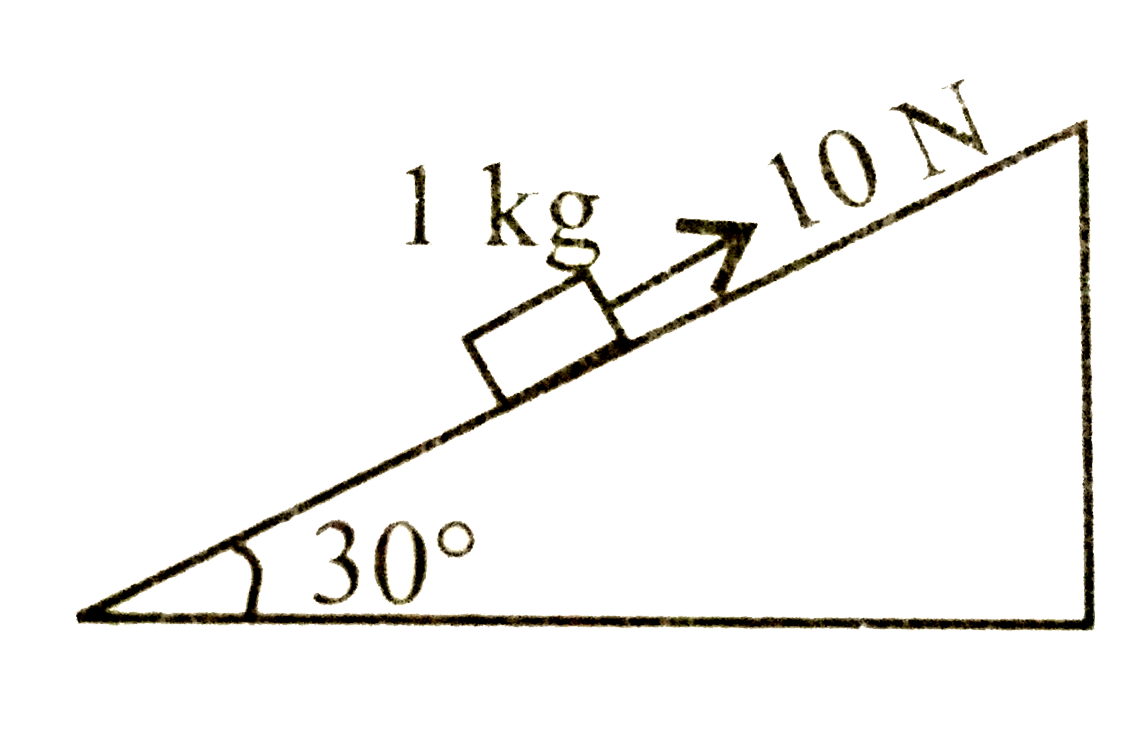
View SolutionA block of mass 5 kg slides down a rough inclined surface. The angle of inclination is 45^(@) . The coefficient of sliding friction is 0.20. When the block slides 10 cm, the work done on the block by force of friction is
View SolutionA person pushes a block of mass 4 kg up a frictionless inclined plane 10 m long and that makes an angle of 30^@ with the horizontal . Then the work done is
View SolutionA block of mass 10 kg slides down on an incline 5 m long and 3 m high. A man pushes up on the ice block parallel to the incline so that it slides down at constant speed. The coefficient of friction between the ice and the incline is 0.1. Find : (a) the work done by the man on the block. (b) the work done by gravity on the block. (c) the work done by the surface on the block. (d) the work done by the resultant forces on the block. (e) the change in K.E. of the block.
View SolutionA Rough inclined plane with inclination 30^(@) with the horizontal has a block of 1 kg being pushed up the plane by a force of 10 N acting parallel to the plane. If the coefficient of friction between the block and the plane is 0.1 and block is pushed through a distance of 10 m along then incline. What are the increases in the (1) potential energy and (ii) kinetic energy of the block ?
View SolutionA block of mass 0.5 kg has an initial velocity of 10ms−1 down an inclined plane of angle 30∘, the coefficient of friction between the block and the inclined surface is 0.2. The velocity of the block after it travels a distance of 10 m is
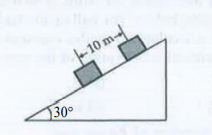
View SolutionA block of mass 1 kg is pushed up a surface inclined to horizontal at an angle of 30∘ by a force of 10 N parallel to the inclined surface as shown in the figure.
The coefficient of friction between block and the incline is 0.1. If the block is pushed up by 10 m along the incline, then the work against gravity is (Take g=10ms−2)

View Solutionक्षैतिज से 30∘ के कोण पर झके एक समतल पृष्ठ पर 1 kg द्रव्यमान का एक ब्लॉक इस आनत समतल के पृष्ठ के समांतर 10 N का बल लगाकर ऊपर की ओर धकेला जाता है। (चित्र )। ब्लॉक एवं आनत समतल के बीच घर्षण गुणांक 0.1 है। यदि ब्लॉक आनत समतल के अनुदिश 10 m की दूरी तक धकेला जाए तो, परिकलन कीजिए
(a) गुरुत्व के विरुद्ध किए गए कार्य की।
(b) घर्षण बल के विरुद्ध किए गए कार्य की ।
(c) स्थितिज ऊर्जा में हुई वृद्धि की।
(d) गतिज ऊर्जा में हुई वृद्धि की।
(e) लगाये गये बल द्वारा किये गये कार्य की।
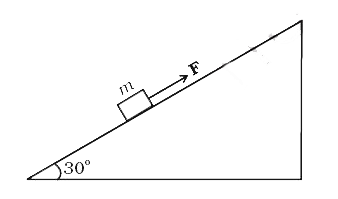
View SolutionA block of mass 5 kg slides down a rough inclined surface. The angle of inclination is 45^(@) . The coefficient of sliding friction is 0.20. When the block slides 10 cm, the work done on the block by force of friction is
View Solution
